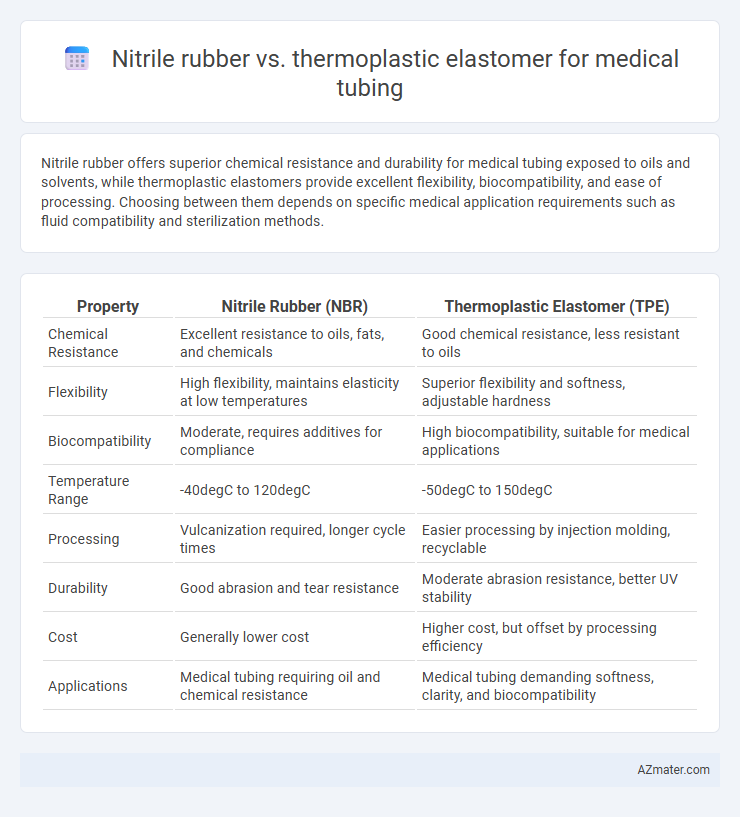Nitrile rubber offers superior chemical resistance and durability for medical tubing exposed to oils and solvents, while thermoplastic elastomers provide excellent flexibility, biocompatibility, and ease of processing. Choosing between them depends on specific medical application requirements such as fluid compatibility and sterilization methods.
Table of Comparison
| Property | Nitrile Rubber (NBR) | Thermoplastic Elastomer (TPE) |
|---|---|---|
| Chemical Resistance | Excellent resistance to oils, fats, and chemicals | Good chemical resistance, less resistant to oils |
| Flexibility | High flexibility, maintains elasticity at low temperatures | Superior flexibility and softness, adjustable hardness |
| Biocompatibility | Moderate, requires additives for compliance | High biocompatibility, suitable for medical applications |
| Temperature Range | -40degC to 120degC | -50degC to 150degC |
| Processing | Vulcanization required, longer cycle times | Easier processing by injection molding, recyclable |
| Durability | Good abrasion and tear resistance | Moderate abrasion resistance, better UV stability |
| Cost | Generally lower cost | Higher cost, but offset by processing efficiency |
| Applications | Medical tubing requiring oil and chemical resistance | Medical tubing demanding softness, clarity, and biocompatibility |
Introduction to Medical Tubing Materials
Medical tubing materials like nitrile rubber and thermoplastic elastomers (TPE) are critical in healthcare for their chemical resistance and flexibility. Nitrile rubber offers excellent resistance to oils, fuels, and certain chemicals, making it suitable for applications requiring durability and puncture resistance. Thermoplastic elastomers provide superior elasticity, easy processing, and biocompatibility, often preferred for disposable or flexible medical tubing with stringent safety standards.
Overview of Nitrile Rubber
Nitrile rubber (NBR) is a synthetic elastomer widely used in medical tubing due to its excellent resistance to oils, fuels, and chemicals, making it ideal for medical devices exposed to harsh environments. Its high tensile strength and resistance to abrasion ensure durability, while its biocompatibility and ability to withstand sterilization processes meet stringent healthcare standards. Compared to thermoplastic elastomers, nitrile rubber offers superior chemical resistance and mechanical stability in demanding medical applications.
Overview of Thermoplastic Elastomer (TPE)
Thermoplastic elastomers (TPE) used in medical tubing offer excellent flexibility, chemical resistance, and biocompatibility, making them ideal for applications requiring repeated sterilization and patient safety. Unlike nitrile rubber, TPE materials are recyclable and allow for easier manufacturing processes such as injection molding and extrusion, reducing production costs. Their high transparency and resistance to kinking enhance performance in intravenous and diagnostic tubing, supporting precise fluid delivery and patient comfort.
Material Composition and Properties
Nitrile rubber (NBR) is a synthetic copolymer of acrylonitrile and butadiene, known for its excellent resistance to oils, chemicals, and punctures, making it ideal for durable medical tubing applications requiring high chemical stability. Thermoplastic elastomers (TPE) consist of a blend of polymers combining rubber-like elasticity with thermoplastic processability, offering superior flexibility, biocompatibility, and ease of sterilization in medical tubing. The material composition of NBR grants it superior chemical resistance, while TPE provides enhanced adaptability and patient comfort due to its softer texture and recyclable nature.
Biocompatibility and Safety Standards
Nitrile rubber offers excellent biocompatibility with high resistance to oils and chemicals, meeting ASTM D2000 and ISO 10993 safety standards for medical tubing applications. Thermoplastic elastomers (TPE) provide superior flexibility and ease of sterilization while complying with FDA and USP Class VI biocompatibility requirements. Both materials ensure safety in medical environments, though TPEs typically support broader sterilization methods without compromising structural integrity.
Flexibility and Mechanical Performance
Nitrile rubber offers superior chemical resistance and excellent mechanical strength, making it highly durable and resistant to punctures in medical tubing applications requiring flexibility and resilience. Thermoplastic elastomers provide greater elasticity and easier processing with consistent flexibility over a wide temperature range, allowing for prolonged use without material fatigue. The choice between nitrile rubber and thermoplastic elastomers depends on specific mechanical performance needs, such as tensile strength and elongation, as well as exposure to chemicals and sterilization methods.
Chemical Resistance and Compatibility
Nitrile rubber exhibits superior chemical resistance to oils, fuels, and many solvents, making it ideal for medical tubing exposed to aggressive chemicals and alcohol-based disinfectants. Thermoplastic elastomers (TPE) offer broad compatibility with various fluids but may degrade faster when in contact with strong acids or solvents commonly used in medical environments. Selecting nitrile rubber ensures greater durability and chemical stability in medical tubing applications requiring frequent exposure to harsh chemicals and sterilization processes.
Sterilization Methods and Durability
Nitrile rubber exhibits excellent resistance to autoclaving and gamma sterilization, maintaining its structural integrity and flexibility under repeated sterilization cycles, making it highly durable for medical tubing applications. Thermoplastic elastomers (TPEs) tolerate ethylene oxide and gamma sterilization well but may experience reduced mechanical strength or deformation after repeated autoclave exposure. The choice between nitrile rubber and TPEs for medical tubing depends on the specific sterilization method employed and the required durability, with nitrile rubber offering superior longevity in high-temperature sterilization environments.
Cost and Manufacturing Efficiency
Nitrile rubber offers lower material costs compared to thermoplastic elastomers, making it a budget-friendly option for medical tubing production. Manufacturing efficiency is enhanced with nitrile rubber due to its straightforward molding and curing processes, reducing cycle times and energy consumption. Thermoplastic elastomers provide faster production cycles through injection molding but generally incur higher raw material costs, impacting overall cost-efficiency in large-scale manufacturing.
Application Suitability: Nitrile Rubber vs TPE
Nitrile rubber offers superior resistance to oils, fuels, and chemicals, making it highly suitable for medical tubing exposed to aggressive fluids or requiring puncture resistance. Thermoplastic elastomers (TPE) provide excellent flexibility, biocompatibility, and ease of processing with lower environmental impact, ideal for soft, patient-contact applications like catheters and flexible connectors. Application suitability depends on specific medical tubing requirements such as chemical exposure, flexibility, and regulatory compliance, with nitrile excelling in durability and TPE favored for comfort and versatility.

Infographic: Nitrile rubber vs Thermoplastic elastomer for Medical tubing
 azmater.com
azmater.com